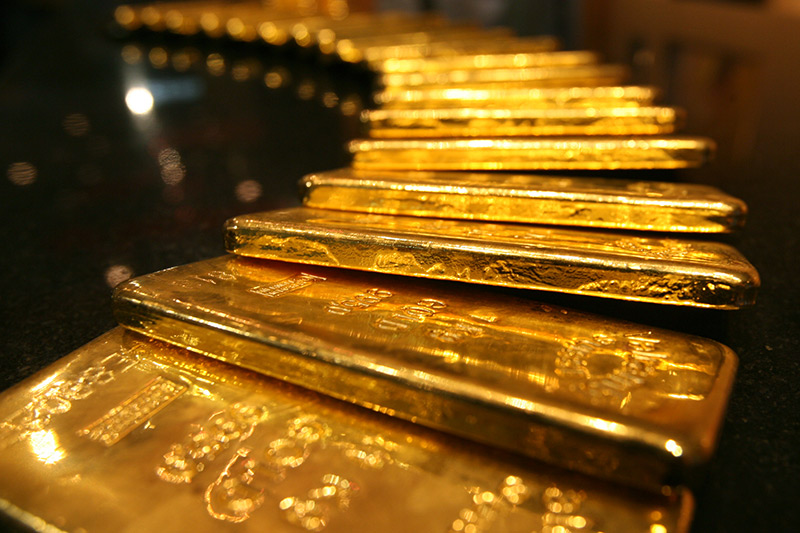Investing.com - Gold prices rose in choppy trading on Monday after soft Chinese and European economic indicators coupled with U.S. fiscal uncertainties fueled talk central banks around the world will keep monetary stimulus measures in place.
Monetary stimulus tools weaken paper currencies to spur recovery, which makes gold an attractive hedge, especially when the U.S. dollar slides.
On the Comex division of the New York Mercantile Exchange, gold futures for April delivery were up 0.01% at USD1,572.50 a troy ounce in U.S. trading on Monday, up from a session low of USD1,570.20 and down from a high of USD1,584.20 a troy ounce.
Gold futures were likely to test support USD1,564.20 a troy ounce, Friday's low, and resistance at USD1,619.40, last Tuesday's high.
Soft manufacturing data out of China and fiscal woes in the U.S. sent gold prices gaining on Monday amid talk monetary policies will stay loose, though trading was choppy, with the metal jumping in and out of positive territory.
The Federal Reserve is currently running a USD85 billion monthly bond-buying program, a stimulus tool known as quantitative easing that spurs the economy by flooding it with liquidity, which pushes up gold prices and weakens the dollar as side effects.
Other central banks have carried out similar measures, and may continue to do so in the near future.
China reported on Friday that the country's February purchasing managers' index fell to 50.1 from 50.4 in January, defying economists' expectations for a 50.5 reading.
While readings above 50 signal expansion, the decline caught markets off guard.
Elsewhere, China’s non-manufacturing PMI fell to 54.5 in February from 56.2 in January,
Meanwhile in the U.S., uncertainty continued to surround the USD85 billion in automatic spending cuts that began to take effect on Friday.
Automatic spending cuts will affect many federal programs and eliminate jobs, shaving as much as half of a percentage point off growth rates for this year, according to some estimates, which could prompt the Federal Reserve to keep its quantitative easing program in place for longer than once thought.
Meanwhile in Europe, the Sentix index of investor confidence for the eurozone dropped to -10.6 in March from -3.9 the previous month, worse than expectations for a decline to -5.2, which fueled dollar demand.
Elsewhere on the Comex, silver for May delivery was up 0.08% and trading at USD28.513 a troy ounce, while copper for May delivery was up 0.08% and trading at USD3.504 a pound.
Monetary stimulus tools weaken paper currencies to spur recovery, which makes gold an attractive hedge, especially when the U.S. dollar slides.
On the Comex division of the New York Mercantile Exchange, gold futures for April delivery were up 0.01% at USD1,572.50 a troy ounce in U.S. trading on Monday, up from a session low of USD1,570.20 and down from a high of USD1,584.20 a troy ounce.
Gold futures were likely to test support USD1,564.20 a troy ounce, Friday's low, and resistance at USD1,619.40, last Tuesday's high.
Soft manufacturing data out of China and fiscal woes in the U.S. sent gold prices gaining on Monday amid talk monetary policies will stay loose, though trading was choppy, with the metal jumping in and out of positive territory.
The Federal Reserve is currently running a USD85 billion monthly bond-buying program, a stimulus tool known as quantitative easing that spurs the economy by flooding it with liquidity, which pushes up gold prices and weakens the dollar as side effects.
Other central banks have carried out similar measures, and may continue to do so in the near future.
China reported on Friday that the country's February purchasing managers' index fell to 50.1 from 50.4 in January, defying economists' expectations for a 50.5 reading.
While readings above 50 signal expansion, the decline caught markets off guard.
Elsewhere, China’s non-manufacturing PMI fell to 54.5 in February from 56.2 in January,
Meanwhile in the U.S., uncertainty continued to surround the USD85 billion in automatic spending cuts that began to take effect on Friday.
Automatic spending cuts will affect many federal programs and eliminate jobs, shaving as much as half of a percentage point off growth rates for this year, according to some estimates, which could prompt the Federal Reserve to keep its quantitative easing program in place for longer than once thought.
Meanwhile in Europe, the Sentix index of investor confidence for the eurozone dropped to -10.6 in March from -3.9 the previous month, worse than expectations for a decline to -5.2, which fueled dollar demand.
Elsewhere on the Comex, silver for May delivery was up 0.08% and trading at USD28.513 a troy ounce, while copper for May delivery was up 0.08% and trading at USD3.504 a pound.
